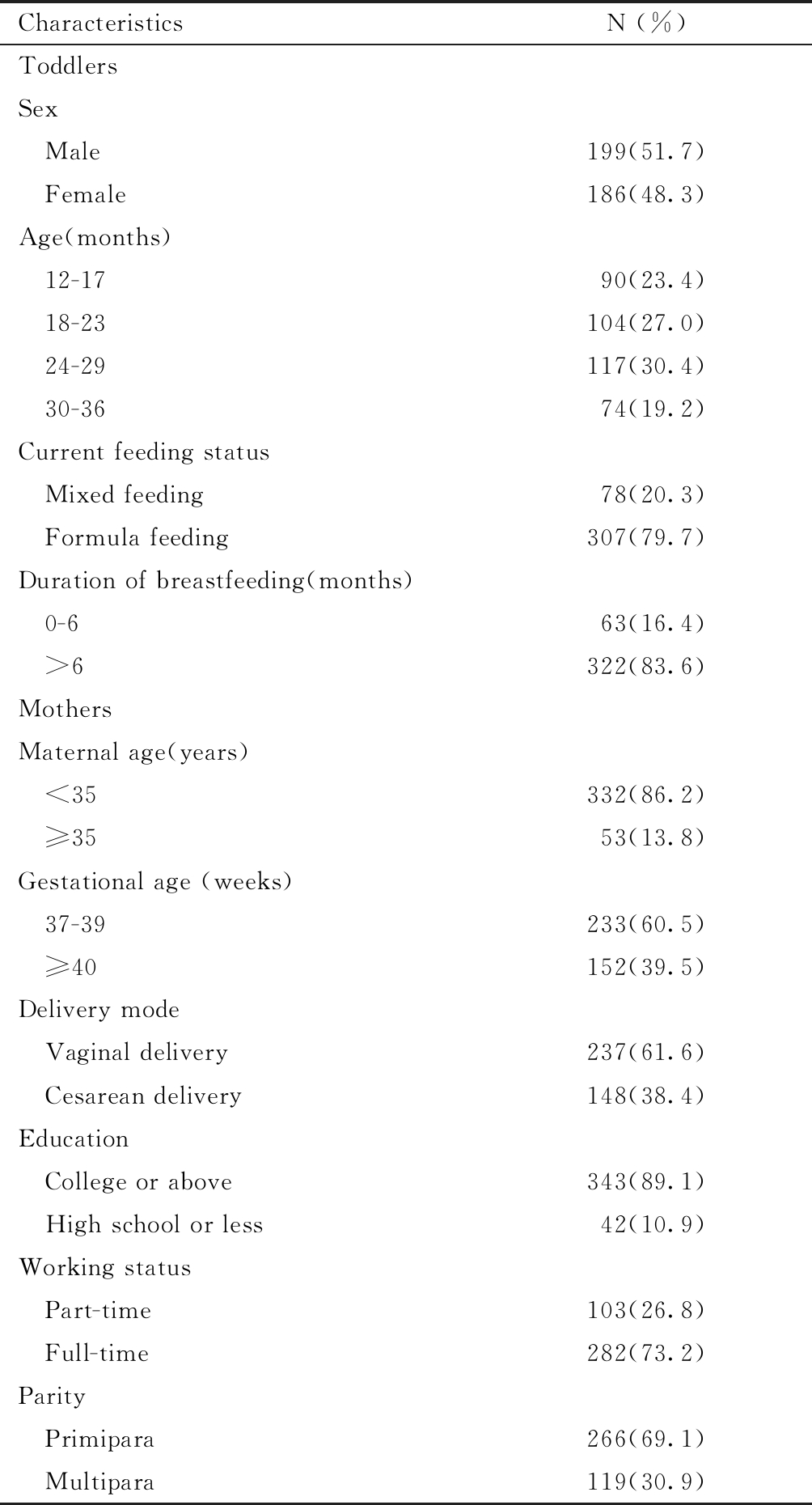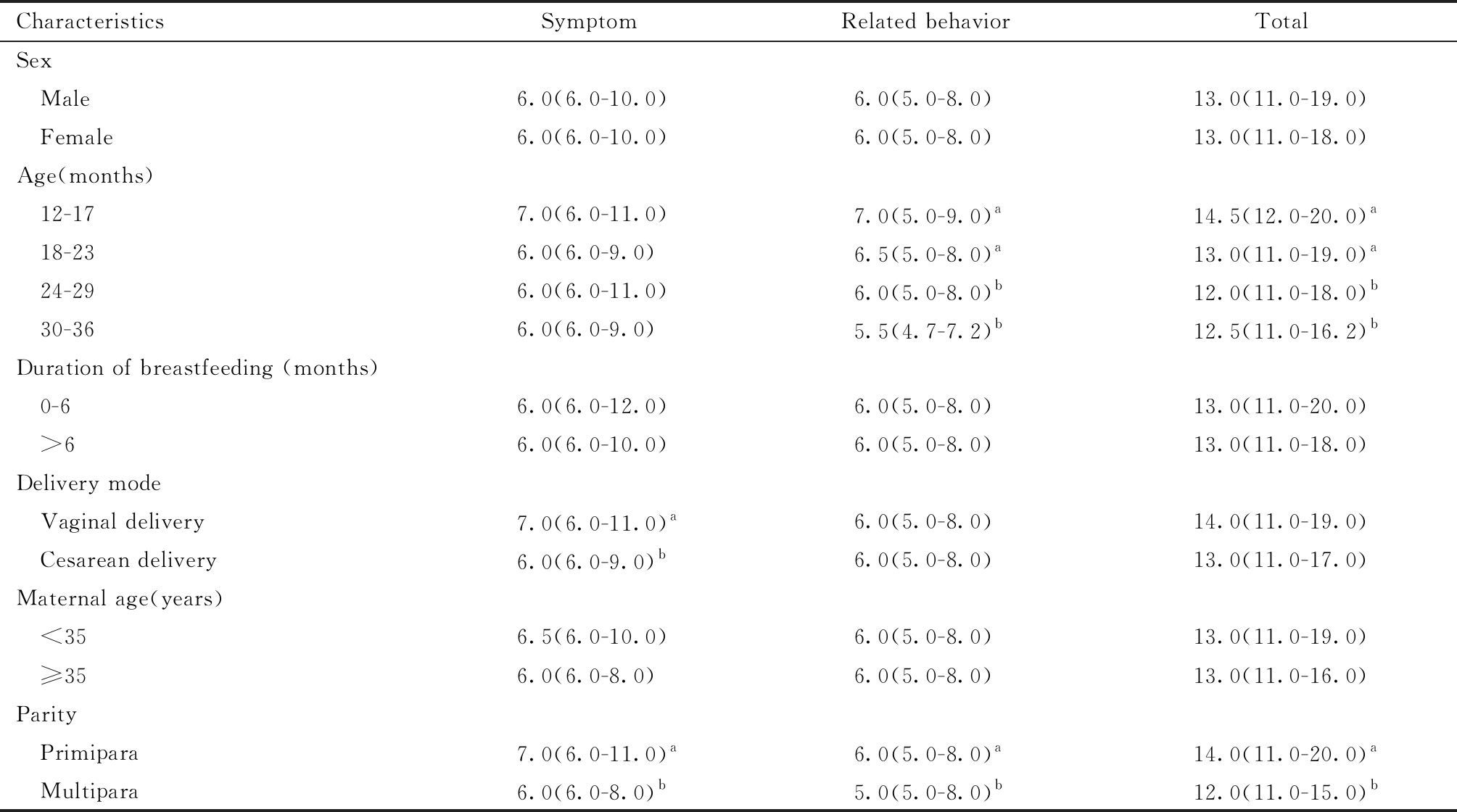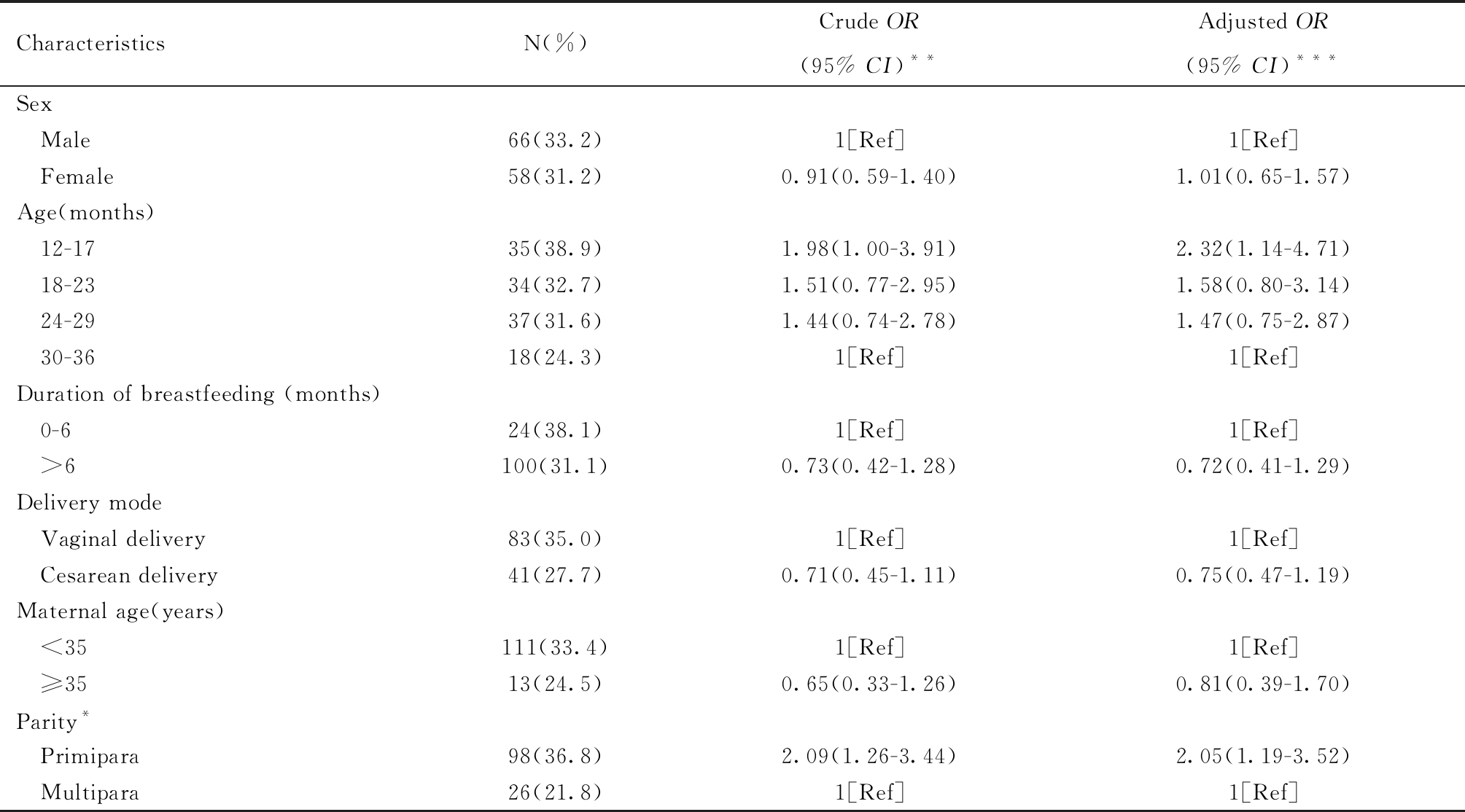·妇幼保健·
12~36月龄幼儿胃肠道功能情况及其影响因素研究
孟莹 唐友池 程志浩 李宏田 周玉博 刘建蒙
【摘要】 目的 描述12~36月龄幼儿胃肠道功能情况,探讨潜在影响因素。 方法 2018年9月—2019年1月在北京市朝阳区某社区卫生服务中心招募12~36月龄幼儿385名,收集幼儿及母亲基本信息,采用简版《婴幼儿胃肠道症状问卷》评估幼儿胃肠道功能。问卷共10个问题,反映幼儿胃肠道症状(6个问题)和相关行为(4个问题)。胃肠道功能总评分为10~60分,其中胃肠道症状6~36分、胃肠道相关行为4~24分,评分越高提示胃肠功能越弱;将总评分等于或高于第二个三分位数(17分)定义为轻度胃肠不适。采用多因素logistic回归分析幼儿轻度胃肠不适的可能影响因素。 结果 幼儿胃肠道功能总评分、症状评分和相关行为评分的中位数(四分位数间距)分别为13.0(11.0~19.0)分、6.0(6.0~10.0)分和6.0(5.0~8.0)分。小月龄(12~17月龄14.5分,18~23月龄13.0分)比大月龄(24~29月龄12.0分,30~36月龄12.5分)、母亲为初产妇(14.0分)比经产妇(12.0分)的幼儿中位胃肠道功能总评分高(P<0.05)。轻度胃肠不适幼儿124名(32.2%),母亲为初产妇(36.8%)比母亲为经产妇(21.8%)的幼儿轻度胃肠不适发生率显著升高(P=0.004)。多因素logistic回归分析显示,12~17月龄幼儿与30~36月龄幼儿相比(调整OR,2.32; 95% CI, 1.14~4.71)、母亲为初产妇的幼儿与经产妇的幼儿相比(调整OR,2.05; 95% CI, 1.19~3.52),轻度胃肠不适风险显著升高。幼儿性别、分娩方式、母乳喂养时长和母亲分娩年龄对轻度胃肠不适发生风险无显著影响。 结论 幼儿胃肠道功能整体较好,幼儿月龄及母亲产次影响幼儿胃肠功能,小月龄及母亲为初产妇的幼儿易发生轻度胃肠不适。
【关键词】 胃肠道功能; 轻度胃肠不适; 幼儿; 现况研究; 危险因素
基金项目:惠氏营养品(中国)有限公司资助项目(MED20180607A)
作者单位:100191,北京大学生育健康研究所,国家卫生健康委员会生育健康重点实验室(孟莹,程志浩,李宏田,周玉博,刘建蒙);北京大学公共卫生学院流行病与卫生统计学系(孟莹,程志浩,李宏田,周玉博,刘建蒙);北京市朝阳区妇幼保健院信息管理科(唐友池)
通讯作者:刘建蒙(liujm@pku.edu.cn);周玉博(zhouyubo@bjmu.edu.cn)
Analysis of gastrointestinal function in toddlers aged 12-36 months and its influencing factors
MENG Ying, TANG Youchi, CHENG Zhihao, LI Hongtian, ZHOU Yubo, LIU Jianmeng.
Institute of Reproductive and Child Health/National Health Commission Key Laboratory of Reproductive Health, Peking University, Beijing 100191, China
[Abstract] Objective To describe the gastrointestinal function among toddlers (12-36 months) and explore its potential influencing factors. Methods A total of 385 toddlers aged 12-36 months were recruited from September 2018 and January 2019 in a community health service center in Chaoyang District, Beijing. Characteristics of toddlers and their mothers were collected, and the gastrointestinal function of toddlers was evaluated using a simplified Infant Gastrointestinal Symptom Questionnaire (IGSQ). The questionnaire included 10 questions which reflected gastrointestinal symptoms (6 questions) and related behaviors (4 questions). The total score of gastrointestinal function ranged from 10 to 60, among which symptom score ranged from 6 to 36 and related behavior score ranged from 4 to 24. The higher the score indicated that the worse the gastrointestinal function was, and the total score equal to or higher than the second tertiles (score=17) was defined as mild gastrointestinal discomfort. Multivariate logistic regression was used to analyze the potential influencing factors of mild gastrointestinal discomfort. Results The medians (interquartile ranges) of total gastrointestinal function score, symptom score and related behavior score were 13.0 (11.0-19.0), 6.0 (6.0-10.0) and 6.0 (5.0-8.0), respectively. The median score of total gastrointestinal function score was significantly higher in younger (14.5 among toddles aged 12-17 months, 13.0 among toddles aged 18-23 months) than older toddlers (12.5 among toddles aged 24-29 months, 12.0 among toddles aged 30-36 months), and higher in toddlers delivered by primipara (14.0) than in those by multipara (12.0) (P<0.05). Among the 385 toddlers, 124 (32.2%) had mild gastrointestinal discomfort. The incidence of mild gastrointestinal discomfort was significantly higher in toddlers delivered by primipara (36.8%) than in those by multipara (21.8%) (P=0.004). The multivariate logistic regression analyses showed that the risk of mild gastrointestinal discomfort was significantly higher in toddlers aged 12-17 months compared to those aged 30-36 months (adjusted OR, 2.32; 95% CI, 1.14-4.71), and in toddlers delivered by primipara compared to those by multipara (adjusted OR, 2.05; 95% CI, 1.19-3.52). The risk of mild gastrointestinal discomfort was not significantly affected by sex, delivery mode, duration of breastfeeding and maternal age at delivery. Conclusion Toddlers in our study had a generally good gastrointestinal function. Age of toddlers and maternal parity might influence gastrointestinal function. Younger toddlers and those delivered by primipara mother had a higher risk of mild gastrointestinal discomfort.
[Key words] Gastrointestinal function; Mild gastrointestinal discomfort; Toddlers; Cross-sectional study; Influencing factors
婴幼儿神经系统尚待发育、内脏敏感性较高、消化吸收功能较弱,常出现便秘、腹泻、胀气、哭闹等功能性胃肠道症状。这些症状多较轻,未达到临床上功能性胃肠病的诊断标准,可定义为轻度胃肠功能不适或紊乱。虽然轻度胃肠不适属于非器质性疾病,不影响生长发育,多随年龄增加而好转,但会引起婴幼儿不适及家长焦虑,且其发生率较高,故倍受关注[1]。2014年一项国际研究估计,全球有近1/3的婴儿罹患至少1种功能性肠胃病[2];同年我国15个主要城市开展的大规模调查发现,1~12月龄婴儿中存在胃肠道问题者占33.6%[3]。2016年,对我国7大城市2万余名0~3岁婴幼儿调查显示,功能性便秘发生率为8.4%,5月龄以内婴儿肠绞痛发生率为7.3%[4]。既往婴幼儿胃肠道功能情况的研究较少、多为对一种或几种具体症状的定性调查,且各研究采用标准不同,未见对中国婴幼儿胃肠道功能情况的定量研究。
婴幼儿轻度胃肠不适的影响因素和可能机制尚无定论。遗传、围产因素和喂养方式等对婴幼儿胃肠道功能的影响备受关注。Salvatore[5]等对意大利1岁以内婴儿的研究显示,早产、剖宫产、人工喂养及抗生素使用可增加婴儿功能性胃肠病的发生风险。然Ley等又提到母乳喂养、分娩方式和抗生素使用等对幼儿胃肠道功能的影响尚不明确,有待进一步研究[6]。尚无研究报道中国婴幼儿人群中胃肠道功能的影响因素。本研究采用简版《婴幼儿胃肠道症状问卷(infant gastrointestinal symptom questionnaire (IGSQ))》,定量调查12~36月龄幼儿胃肠道功能情况,并分析影响幼儿胃肠道功能的潜在因素。
对象与方法
一、研究对象
2018年9月—2019年1月在北京市朝阳区某社区卫生服务中心募集12~36月龄幼儿开展现况研究。由统一培训的社区卫生服务中心儿保科医生在幼儿进行常规体检时募集研究对象。纳入标准包括:12~36月龄、足月产(≥37孕周)、出生体重2.5~4.5 kg、目前食用奶粉;排除标准包括:患有慢性感染、代谢、遗传或其他疾病,对牛奶蛋白过敏,有认知或发育障碍,食用过特殊婴儿配方粉。共募集幼儿387名,剔除母乳喂养情况缺失者1名、有功能性胃肠病家族史者1名,最终纳入分析者385名。本研究经北京大学医学部伦理委员会审查批准(批准号:IRB00001052-18063),所募集幼儿的父母或法定监护人均签署知情同意书。
二、方法
本研究采用手机微信公众平台,由儿保科医生指导幼儿父母或监护人填写相关问卷。
1.基本信息:幼儿基本信息包括性别、月龄、分娩时孕周、分娩方式、母乳喂养时长及现喂养方式。幼儿性别分男和女;月龄分12~17月龄、18~23月龄、24 ~29月龄、30~36月龄;分娩时孕周分37~39周和40周及以上;分娩方式分阴道产和剖宫产;母乳喂养时长分0~6个月和6个月以上;现喂养方式分混合喂养(母乳喂养合并人工喂养)和纯人工喂养。母亲基本信息包括分娩年龄、文化程度、工作状况和分娩幼儿时的产次。母亲分娩年龄分<35岁和35岁及以上;文化程度分高中及以下、大学及以上;工作状况分全职工作和非全职工作;产次分初产和经产。
2.胃肠道功能评估及相关定义:采用简版《婴幼儿胃肠道症状问卷》评估幼儿胃肠道功能。该问卷的信度和效度在中国和美国等国家婴幼儿人群中已得到验证[7]。问卷共有10个问题,反映幼儿胃肠道症状(6个问题)和相关行为(4个问题)。胃肠道症状包括便秘、腹泻、腹痛、腹胀等,相关行为包括烦躁、睡眠、困倦等。每个问题的评分,依据症状或相关行为的严重程度,由轻至重依次为1~6分,胃肠道功能总评分为10~60分,其中胃肠道症状6~36分、胃肠道相关行为4~24分。评分越高提示胃肠功能越弱。为便于定性描述以及分析胃肠道功能影响因素,将总评分等于或高于第二个三分位数(17分)定义为轻度胃肠不适。
3.统计分析
应用SPSS 24.0统计学软件分析资料,双侧P<0.05为差异有统计学意义。Kolmogorov-Smirnov正态性检验显示,胃肠道功能总评分、胃肠道症状评分和胃肠道相关行为评分均呈非正态分布(P<0.001),故采用中位数(四分位数间距)予以描述。轻度胃肠不适发生率以频数(百分比)表示。采用Mann-Whitney检验比较幼儿胃肠道功能总评分、症状评分和相关行为评分在幼儿性别、分娩方式别、产次别等二分类变量的组间差异;采用Kruskal-Wallis检验比较不同月龄(多分类变量)间的差异;采用卡方检验比较轻度胃肠不适发生率在上述不同亚组间的差异。多重比较时,采用Bonferroni法进行校正。采用单因素和多因素logistic回归分析,研究各因素与轻度胃肠不适的关联程度;多因素分析时调整变量包括幼儿性别、月龄、分娩方式、母乳喂养时长、母亲分娩年龄和产次。
结 果
一、基本情况
在纳入分析的385名幼儿中,男孩占51.7%,12~17月龄、18~23月龄、24~29月龄和30~36月龄者分别占23.4%、27.0%、30.4%和19.2%,孕周为37~39周者占60.5%,经阴道分娩者占61.6%,母乳喂养6个月以上者占83.6%。多数幼儿母亲分娩年龄低于35岁(86.2%)、初产(69.1%)。幼儿及母亲其他特征详见表1。
二、不同特征幼儿胃肠道功能评分情况
幼儿胃肠道功能总评分、症状评分和相关行为评分的中位数(四分位数间距)分别为13.0(11.0~19.0)分、6.0(6.0~10.0)分和6.0(5.0~8.0)分。与大月龄(24~29月龄总评分12.0分,30~36月龄总评分12.5分)幼儿相比,小月龄(12~17月龄总评分14.5分,18~23月龄总评分13.0分)幼儿的中位胃肠道功能总评分较高(P<0.05)。与母亲为经产妇的幼儿相比,母亲为初产妇的幼儿中位胃肠道功能总评分(12.0 vs. 14.0分)、胃肠道症状评分(6.0 vs 7.0分)及相关行为评分(5.0 vs. 6.0分)均较高(P<0.05)。详见表2。
三、幼儿轻度胃肠不适的logistic回归分析
在385名幼儿中,轻度胃肠不适者124名(32.2%)。母亲为初产妇的幼儿轻度胃肠不适发生率(36.8%)显著高于母亲为经产妇的幼儿(21.8%)(P=0.004),其他亚组间轻度胃肠不适发生率未见统计学差异。单因素分析显示,与30~36月龄幼儿相比,12~17月龄幼儿轻度胃肠不适发生风险较高(OR,1.98;95% CI,1.00~3.91);与母亲为经产妇的幼儿相比,母亲为初产妇的幼儿轻度胃肠不适发生风险较高(OR,2.09;95% CI,1.26~3.44)。调整幼儿性别、月龄、分娩方式、母乳喂养时长、母亲分娩年龄和产次等混杂因素后12~17月龄幼儿(调整OR,2.32; 95% CI, 1.14~4.71)和母亲为初产妇的幼儿轻度胃肠不适发生风险仍较高(调整OR,2.05; 95% CI, 1.19~3.52)。幼儿性别、分娩方式、母乳喂养时长和母亲分娩年龄对轻度胃肠不适发生风险无显著影响。见表3。
表1 12~36月龄幼儿和母亲基本特征情况
Table 1 Characteristics of toddler (12-36 months) and their mothers

CharacteristicsN (%)ToddlersSex Male199(51.7) Female186(48.3)Age(months) 12-17 90(23.4) 18-23104(27.0) 24-29117(30.4) 30-36 74(19.2)Current feeding status Mixed feeding 78(20.3) Formula feeding307(79.7)Duration of breastfeeding(months) 0-6 63(16.4) >6322(83.6)MothersMaternal age(years) <35332(86.2) ≥35 53(13.8)Gestational age (weeks) 37-39233(60.5) ≥40152(39.5)Delivery mode Vaginal delivery237(61.6) Cesarean delivery148(38.4)Education College or above343(89.1) High school or less 42(10.9)Working status Part-time103(26.8) Full-time282(73.2)Parity Primipara266(69.1) Multipara119(30.9)
表2 不同特征幼儿胃肠道症状、相关行为及总评分情况[中位数(四分位数间距)]
Table 2 Scores of symptom, related behavior and total gastrointestinal function by characteristics [median (interquartile range)]

CharacteristicsSymptom Related behavior TotalSex Male6.0(6.0-10.0)6.0(5.0-8.0)13.0(11.0-19.0) Female6.0(6.0-10.0)6.0(5.0-8.0)13.0(11.0-18.0)Age(months) 12-177.0(6.0-11.0)7.0(5.0-9.0)a14.5(12.0-20.0)a 18-236.0(6.0-9.0)6.5(5.0-8.0)a13.0(11.0-19.0)a 24-296.0(6.0-11.0)6.0(5.0-8.0)b12.0(11.0-18.0)b 30-366.0(6.0-9.0)5.5(4.7-7.2)b12.5(11.0-16.2)bDuration of breastfeeding (months) 0-66.0(6.0-12.0)6.0(5.0-8.0)13.0(11.0-20.0) >66.0(6.0-10.0)6.0(5.0-8.0)13.0(11.0-18.0)Delivery mode Vaginal delivery7.0(6.0-11.0)a6.0(5.0-8.0)14.0(11.0-19.0) Cesarean delivery6.0(6.0-9.0)b6.0(5.0-8.0)13.0(11.0-17.0)Maternal age(years) <356.5(6.0-10.0)6.0(5.0-8.0)13.0(11.0-19.0) ≥356.0(6.0-8.0)6.0(5.0-8.0)13.0(11.0-16.0)Parity Primipara7.0(6.0-11.0)a6.0(5.0-8.0)a14.0(11.0-20.0)a Multipara6.0(6.0-8.0)b5.0(5.0-8.0)b12.0(11.0-15.0)b
Note: Values not sharing the same superscript letter (a, b) denote significant differences across subgroups stritified by characteristics (P<0.05): scores of a > b.
表3 幼儿轻度胃肠不适的影响因素分析
Table 3 Analyses of influencing factors of mild gastrointestinal discomfort in toddlers

CharacteristicsN(%)Crude OR (95% CI)**Adjusted OR(95% CI)***Sex Male66(33.2)1[Ref]1[Ref] Female58(31.2)0.91(0.59-1.40)1.01(0.65-1.57)Age(months) 12-1735(38.9)1.98(1.00-3.91)2.32(1.14-4.71) 18-2334(32.7)1.51(0.77-2.95)1.58(0.80-3.14) 24-2937(31.6)1.44(0.74-2.78)1.47(0.75-2.87) 30-3618(24.3)1[Ref]1[Ref]Duration of breastfeeding (months) 0-624(38.1)1[Ref]1[Ref] >6 100(31.1)0.73(0.42-1.28)0.72(0.41-1.29)Delivery mode Vaginal delivery83(35.0)1[Ref]1[Ref] Cesarean delivery41(27.7)0.71(0.45-1.11)0.75(0.47-1.19)Maternal age(years) <35 111(33.4)1[Ref]1[Ref] ≥3513(24.5)0.65(0.33-1.26)0.81(0.39-1.70)Parity* Primipara98(36.8)2.09(1.26-3.44)2.05(1.19-3.52) Multipara26(21.8)1[Ref]1[Ref]
*P<0.05, prevalences of mild gastrointestinal discomfort in toddlers significantly differed between primiparae and multiparae; **Crude OR (95% CI) was estimated using univariate logistic regression model; ***Adjusted OR (95% CI) was estimated using multivariate logistic regression model byconsidering sex, age, time of breast feeding, delivery mode, maternal age and parity; Abbreviations: OR, odds ratio; 95% CI: 95% confidence interval.
讨 论
本研究发现,幼儿胃肠道功能总评分的中位数(四分位数间距)为13.0(11.0~19.0)分,提示幼儿胃肠道功能较好。小月龄和母亲初产的幼儿胃肠功能总评分较高,提示其胃肠道功能较弱。将胃肠功能总评分二分类的定性分析也显示,与大月龄、母亲为经产妇幼儿相比,小月龄、母亲为初产妇幼儿发生轻度胃肠不适的风险显著升高。
有关婴幼儿胃肠道功能的流行病学调查研究较少。有限的以社区为基础的调查提示,婴幼儿胃肠不适可能处于较高水平。2015年美国采用罗马III标准线上调查了0~3岁婴幼儿264名,报道功能性胃肠病发生率为27%[1],2018年的调查为25%[8];2019年意大利采用罗马III标准前瞻性调查婴儿1152名,在1月龄、3月龄、6月龄、12月龄时分别评估胃肠道功能,发现至少罹患过1种功能性胃肠道疾病的婴儿占比达77%[5]。2009年我国上海市采用罗马III标准调查0~2岁婴幼儿5030名,结果显示发生或既往发生过胃肠功能紊乱的婴幼儿占比为38%[9];2014年参考我国临床婴儿胃肠道常见问题筛查干预流程,对我国15个主要城市1~12月龄健康婴儿的调查显示,存在胃肠道问题婴儿占34%[3]。既往幼儿群体相关调查的结局指标均为功能性胃肠病,且研究采用标准、调查幼儿年龄等不尽一致,未见中国婴幼儿胃肠道功能情况量化评价研究。《婴幼儿胃肠道症状问卷》的信度和效度已在中、美等国12月龄以内婴儿群体中验证[7],但尚未见应用此问卷对中国12~36月龄健康幼儿的胃肠道功能调查,本研究首次采用简化版《婴幼儿胃肠道症状问卷》调查北京市朝阳区12~36月龄幼儿的胃肠道功能,能够从一个侧面定量反映我国特大城市幼儿胃肠功能水平。
有关婴幼儿月龄与胃肠道功能关系的研究结论尚不一致。2009年在我国上海市0~2岁婴幼儿中发现,婴幼儿胃肠不适发生率因月龄而异,随月龄增加,便秘和溢奶逐渐减少、但腹泻增加[9];2014年在我国15城市1~12月龄健康婴儿中发现,随月龄增加,溢奶、过度哭闹、稀便逐渐减少,但排便困难或大便干燥增加[3]。研究结果不完全一致,可能与研究人群的年龄、健康状况及结局定义等方面的差异有关。本研究发现,随着月龄增加,幼儿胃肠道功能逐渐改善,31~36月龄幼儿轻度胃肠不适发生风险显著低于12~17月龄幼儿,提示高月龄幼儿胃肠道功能增强、不易发生轻度胃肠不适情况。既往研究也发现婴幼儿胃肠不适可能存在“年龄依赖性”[10]现象,即随着年龄增长,婴幼儿胃肠道功能逐渐发育成熟,胃肠不适发生风险自然会降低。本研究还发现,母亲为经产妇的幼儿轻度胃肠不适发生风险显著低于母亲为初产妇的幼儿,这可能与经产妇喂养经验较丰富、初产妇对幼儿胃肠不适症状更关注或更敏感有关。
本研究未发现幼儿轻度胃肠不适发生情况有性别差异,这与国内外多数研究结果相一致[1,3,4,9,11,12]。有研究发现,女孩较男孩易出现功能性胃肠病的症状如腹痛,但性别差异一般早到4~6岁、晚到青春期才显现[13]。此外,既往研究提示,剖宫产可能增加婴儿功能性胃肠道疾病发生风险[5],但本研究未发现分娩方式与幼儿轻度胃肠不适有关联,这与Gondwe[14]等在印度小于6月龄婴儿中的研究结果相一致。有研究显示母乳中含有益乳酸菌等益生菌,有益于幼儿胃肠道健康[15, 16]。本研究发现,母乳喂养时长6个月以上幼儿的轻度胃肠不适发生率(31.1%)低于喂养时长不足6个月幼儿(38.1%),但该差异没有统计显著性,这可能与研究样本量不足有关。欲检出两组幼儿轻度胃肠不适发生率相差7%的统计学差异(P<0.05),所需样本量为1448例。
本研究调查了12~36 月龄幼儿胃肠道功能情况,评估了幼儿轻度胃肠不适的潜在影响因素。研究结果显示,幼儿胃肠道功能总评分、症状评分和相关行为评分的中位数(四分位数间距)分别为13.0(11.0~19.0)分、6.0(6.0~10.0)分和6.0(5.0~8.0)分,小月龄幼儿和母亲为初产妇的幼儿轻度胃肠不适发生风险较高,提示宜关注小月龄幼儿胃肠道功能不适问题,普及幼儿喂养相关知识。本研究首次对中国12~36月龄幼儿胃肠道功能情况的定量评估,并探究幼儿胃肠道功能的影响因素。本研究由经统一培训的医生指导幼儿家长填写问卷,数据可靠;在估计各因素与幼儿胃肠道功能的关联时,连续性变量和分组变量分析结果稳定。研究局限主要包括:存在有限程度的回忆偏倚,未区分医学指征剖宫产与非医学指征剖宫产,未考虑抗生素等潜在混杂因素。此外,调查局限在北京市朝阳区某社区、调查对象局限于12~36月龄幼儿,相关结果或仅反映特大城市幼儿胃肠道功能情况的一个侧面,结果外推须谨慎。
参考文献
1 van Tilburg MA,Hyman PE,Walker L,et al.Prevalence of functional gastrointestinal disorders in infants and toddlers.J Pediatr,2015,166:684-689.
2 Vandenplas Y,Abkari A,Bellaiche M,et al.Prevalence and health outcomes of functional gastrointestinal symptoms in infants from birth to 12 months of age.J Pediatr Gastroenterol Nutr,2015,61:531-537.
3 王硕,王惠珊,盛晓阳,等.中国15城市1~12月龄婴儿胃肠道常见问题的流行状况研究.中国儿童保健杂志,2018,26:611-614.
4 纪文静,梁爱民,曲成毅,等.中国7个城市婴幼儿常见胃肠道不适症状流行病学特征现况调查.中华流行病学杂志,2018,39:1179-1183.
5 Salvatore S,Baldassarre ME,Di Mauro A,et al.Neonatal antibiotics and prematurity are associated with an increased risk of functional gastrointestinal disorders in the first year of life.J Pediatr,2019,212:44-51.
6 Ley D,Desseyn JL,Mischke M,et al.Early-life origin of intestinal inflammatory disorders.Nutr Rev,2017,75:175-187.
7 Riley AW,Trabulsi J,Yao M,et al.Validation of a parent report questionnaire:The infant gastrointestinal symptom questionnaire.Clin Pediatr (Phila),2015,54:1167-1174.
8 Robin SG,Keller C,Zwiener R,et al.Prevalence of pediatric functional gastrointestinal disorders utilizing the rome iv criteria.J Pediatr,2018,195:134-139.
9 刘伟,肖丽萍,李云,等.上海市闵行区婴幼儿轻度胃肠功能紊乱的流行病学调查.中华儿科杂志,2009,47:917-921.
10 武庆斌.婴儿常见的胃肠道不适及处理.中国儿童保健杂志,2015,23:1-6.
11 Ferreira-Maia AP,Matijasevich A,Wang YP.Epidemiology of functional gastrointestinal disorders in infants and toddlers:A systematic review.World J Gastroenterol,2016,22:6547-6558.
12 Rouster AS,Karpinski AC,Silver D,et al.Functional gastrointestinal disorders dominate pediatric gastroenterology outpatient practice.J Pediatr Gastroenterol Nutr,2016,62:847-851.
13 Chitkara DK,Rawat DJ,Talley NJ.The epidemiology of childhood recurrent abdominal pain in Western countries:a systematic review.Am J Gastroenterol.2005,100:1868-1875.
14 Gondwe T,Betha K,Kusneniwar GN,et al.Mode of delivery and short-term infant health outcomes:A prospective cohort study in a peri-urban indian population.BMC Pediatr,2018,18:346.
15 Fouhy F,Watkins C,Hill C J,et al.Perinatal factors affect the gut microbiota up to four years after birth.Nat Commun,2019,10:1517.
16 Akagawa S,Tsuji S,Onuma C,et al.Effect of delivery mode and nutrition on gut microbiota in neonates.Ann Nutr Metab,2019,74:132-139.
(收稿日期:2020-05-12)


